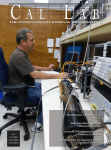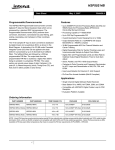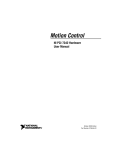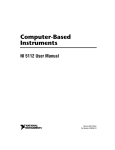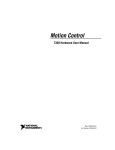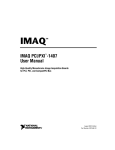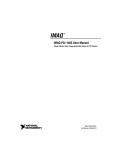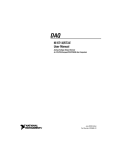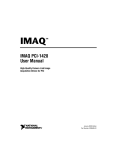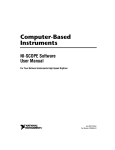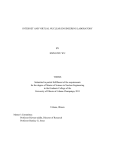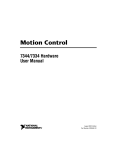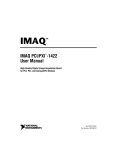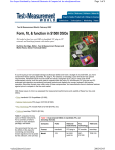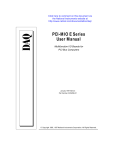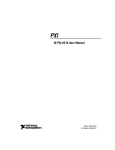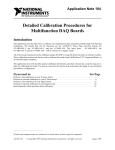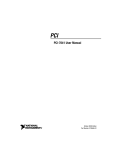Download NI PXI-562x User Manual
Transcript
Computer-Based Instruments NI PXI-562x User Manual High-Speed Frequency-Domain Digitizer NI PXI-562x User Manual July 2002 Edition Part Number 322949C-01 Support Worldwide Technical Support and Product Information ni.com National Instruments Corporate Headquarters 11500 North Mopac Expressway Austin, Texas 78759-3504 USA Tel: 512 683 0100 Worldwide Offices Australia 03 9879 5166, Austria 0662 45 79 90 0, Belgium 02 757 00 20, Brazil 011 3262 3599, Canada (Calgary) 403 274 9391, Canada (Montreal) 514 288 5722, Canada (Ottawa) 613 233 5949, Canada (Québec) 514 694 8521, Canada (Toronto) 905 785 0085, China 86 21 6555 7838, Czech Republic 02 2423 5774, Denmark 45 76 26 00, Finland 09 725 725 11, France 01 48 14 24 24, Germany 089 741 31 30, Greece 01 42 96 427, Hong Kong 2645 3186, India 91 80 4190000, Israel 03 6393737, Italy 02 413091, Japan 03 5472 2970, Korea 02 3451 3400, Malaysia 603 9596711, Mexico 001 800 010 0793, Netherlands 0348 433466, New Zealand 09 914 0488, Norway 32 27 73 00, Poland 22 3390 150, Portugal 210 311 210, Russia 095 238 7139, Singapore 65 6 226 5886, Slovenia 3 425 4200, South Africa 11 805 8197, Spain 91 640 0085, Sweden 08 587 895 00, Switzerland 056 200 51 51, Taiwan 02 2528 7227, United Kingdom 01635 523545 For further support information, see the Technical Support and Professional Services appendix. To comment on the documentation, send email to [email protected]. © 2001–2002 National Instruments Corporation. All rights reserved. Important Information Warranty The NI PXI-5620 and the NI PXI-5621 is warranted against defects in materials and workmanship for a period of one year from the date of shipment, as evidenced by receipts or other documentation. National Instruments will, at its option, repair or replace equipment that proves to be defective during the warranty period. This warranty includes parts and labor. The media on which you receive National Instruments software are warranted not to fail to execute programming instructions, due to defects in materials and workmanship, for a period of 90 days from date of shipment, as evidenced by receipts or other documentation. National Instruments will, at its option, repair or replace software media that do not execute programming instructions if National Instruments receives notice of such defects during the warranty period. National Instruments does not warrant that the operation of the software shall be uninterrupted or error free. A Return Material Authorization (RMA) number must be obtained from the factory and clearly marked on the outside of the package before any equipment will be accepted for warranty work. National Instruments will pay the shipping costs of returning to the owner parts which are covered by warranty. National Instruments believes that the information in this document is accurate. The document has been carefully reviewed for technical accuracy. In the event that technical or typographical errors exist, National Instruments reserves the right to make changes to subsequent editions of this document without prior notice to holders of this edition. The reader should consult National Instruments if errors are suspected. In no event shall National Instruments be liable for any damages arising out of or related to this document or the information contained in it. EXCEPT AS SPECIFIED HEREIN, NATIONAL INSTRUMENTS MAKES NO WARRANTIES, EXPRESS OR IMPLIED, AND SPECIFICALLY DISCLAIMS ANY WARRANTY OF MERCHANTABILITY OR FITNESS FOR A PARTICULAR PURPOSE. CUSTOMER’S RIGHT TO RECOVER DAMAGES CAUSED BY FAULT OR NEGLIGENCE ON THE PART OF NATIONAL INSTRUMENTS SHALL BE LIMITED TO THE AMOUNT THERETOFORE PAID BY THE CUSTOMER. NATIONAL INSTRUMENTS WILL NOT BE LIABLE FOR DAMAGES RESULTING FROM LOSS OF DATA, PROFITS, USE OF PRODUCTS, OR INCIDENTAL OR CONSEQUENTIAL DAMAGES, EVEN IF ADVISED OF THE POSSIBILITY THEREOF. This limitation of the liability of National Instruments will apply regardless of the form of action, whether in contract or tort, including negligence. Any action against National Instruments must be brought within one year after the cause of action accrues. National Instruments shall not be liable for any delay in performance due to causes beyond its reasonable control. The warranty provided herein does not cover damages, defects, malfunctions, or service failures caused by owner’s failure to follow the National Instruments installation, operation, or maintenance instructions; owner’s modification of the product; owner’s abuse, misuse, or negligent acts; and power failure or surges, fire, flood, accident, actions of third parties, or other events outside reasonable control. Copyright Under the copyright laws, this publication may not be reproduced or transmitted in any form, electronic or mechanical, including photocopying, recording, storing in an information retrieval system, or translating, in whole or in part, without the prior written consent of National Instruments Corporation. Trademarks CVI™, LabVIEW™, MITE™, MXI™, National Instruments™, NI™, and ni.com™ are trademarks of National Instruments Corporation. Product and company names mentioned herein are trademarks or trade names of their respective companies. Patents For patents covering National Instruments products, refer to the appropriate location: Help»Patents in your software, the patents.txt file on your CD, or ni.com/patents. WARNING REGARDING USE OF NATIONAL INSTRUMENTS PRODUCTS (1) NATIONAL INSTRUMENTS PRODUCTS ARE NOT DESIGNED WITH COMPONENTS AND TESTING FOR A LEVEL OF RELIABILITY SUITABLE FOR USE IN OR IN CONNECTION WITH SURGICAL IMPLANTS OR AS CRITICAL COMPONENTS IN ANY LIFE SUPPORT SYSTEMS WHOSE FAILURE TO PERFORM CAN REASONABLY BE EXPECTED TO CAUSE SIGNIFICANT INJURY TO A HUMAN. (2) IN ANY APPLICATION, INCLUDING THE ABOVE, RELIABILITY OF OPERATION OF THE SOFTWARE PRODUCTS CAN BE IMPAIRED BY ADVERSE FACTORS, INCLUDING BUT NOT LIMITED TO FLUCTUATIONS IN ELECTRICAL POWER SUPPLY, COMPUTER HARDWARE MALFUNCTIONS, COMPUTER OPERATING SYSTEM SOFTWARE FITNESS, FITNESS OF COMPILERS AND DEVELOPMENT SOFTWARE USED TO DEVELOP AN APPLICATION, INSTALLATION ERRORS, SOFTWARE AND HARDWARE COMPATIBILITY PROBLEMS, MALFUNCTIONS OR FAILURES OF ELECTRONIC MONITORING OR CONTROL DEVICES, TRANSIENT FAILURES OF ELECTRONIC SYSTEMS (HARDWARE AND/OR SOFTWARE), UNANTICIPATED USES OR MISUSES, OR ERRORS ON THE PART OF THE USER OR APPLICATIONS DESIGNER (ADVERSE FACTORS SUCH AS THESE ARE HEREAFTER COLLECTIVELY TERMED “SYSTEM FAILURES”). ANY APPLICATION WHERE A SYSTEM FAILURE WOULD CREATE A RISK OF HARM TO PROPERTY OR PERSONS (INCLUDING THE RISK OF BODILY INJURY AND DEATH) SHOULD NOT BE RELIANT SOLELY UPON ONE FORM OF ELECTRONIC SYSTEM DUE TO THE RISK OF SYSTEM FAILURE. TO AVOID DAMAGE, INJURY, OR DEATH, THE USER OR APPLICATION DESIGNER MUST TAKE REASONABLY PRUDENT STEPS TO PROTECT AGAINST SYSTEM FAILURES, INCLUDING BUT NOT LIMITED TO BACK-UP OR SHUT DOWN MECHANISMS. BECAUSE EACH END-USER SYSTEM IS CUSTOMIZED AND DIFFERS FROM NATIONAL INSTRUMENTS' TESTING PLATFORMS AND BECAUSE A USER OR APPLICATION DESIGNER MAY USE NATIONAL INSTRUMENTS PRODUCTS IN COMBINATION WITH OTHER PRODUCTS IN A MANNER NOT EVALUATED OR CONTEMPLATED BY NATIONAL INSTRUMENTS, THE USER OR APPLICATION DESIGNER IS ULTIMATELY RESPONSIBLE FOR VERIFYING AND VALIDATING THE SUITABILITY OF NATIONAL INSTRUMENTS PRODUCTS WHENEVER NATIONAL INSTRUMENTS PRODUCTS ARE INCORPORATED IN A SYSTEM OR APPLICATION, INCLUDING, WITHOUT LIMITATION, THE APPROPRIATE DESIGN, PROCESS AND SAFETY LEVEL OF SUCH SYSTEM OR APPLICATION. Compliance FCC/Canada Radio Frequency Interference Compliance* Determining FCC Class The Federal Communications Commission (FCC) has rules to protect wireless communications from interference. The FCC places digital electronics into two classes. These classes are known as Class A (for use in industrial-commercial locations only) or Class B (for use in residential or commercial locations). Depending on where it is operated, this product could be subject to restrictions in the FCC rules. (In Canada, the Department of Communications (DOC), of Industry Canada, regulates wireless interference in much the same way.) Digital electronics emit weak signals during normal operation that can affect radio, television, or other wireless products. By examining the product you purchased, you can determine the FCC Class and therefore which of the two FCC/DOC Warnings apply in the following sections. (Some products may not be labeled at all for FCC; if so, the reader should then assume these are Class A devices.) FCC Class A products only display a simple warning statement of one paragraph in length regarding interference and undesired operation. Most of our products are FCC Class A. The FCC rules have restrictions regarding the locations where FCC Class A products can be operated. FCC Class B products display either a FCC ID code, starting with the letters EXN, or the FCC Class B compliance mark that appears as shown here on the right. Consult the FCC Web site at http://www.fcc.gov for more information. FCC/DOC Warnings This equipment generates and uses radio frequency energy and, if not installed and used in strict accordance with the instructions in this manual and the CE Mark Declaration of Conformity**, may cause interference to radio and television reception. Classification requirements are the same for the Federal Communications Commission (FCC) and the Canadian Department of Communications (DOC). Changes or modifications not expressly approved by National Instruments could void the user’s authority to operate the equipment under the FCC Rules. Class A Federal Communications Commission This equipment has been tested and found to comply with the limits for a Class A digital device, pursuant to part 15 of the FCC Rules. These limits are designed to provide reasonable protection against harmful interference when the equipment is operated in a commercial environment. This equipment generates, uses, and can radiate radio frequency energy and, if not installed and used in accordance with the instruction manual, may cause harmful interference to radio communications. Operation of this equipment in a residential area is likely to cause harmful interference in which case the user will be required to correct the interference at his own expense. Canadian Department of Communications This Class A digital apparatus meets all requirements of the Canadian Interference-Causing Equipment Regulations. Cet appareil numérique de la classe A respecte toutes les exigences du Règlement sur le matériel brouilleur du Canada. Class B Federal Communications Commission This equipment has been tested and found to comply with the limits for a Class B digital device, pursuant to part 15 of the FCC Rules. These limits are designed to provide reasonable protection against harmful interference in a residential installation. This equipment generates, uses, and can radiate radio frequency energy and, if not installed and used in accordance with the instructions, may cause harmful interference to radio communications. However, there is no guarantee that interference will not occur in a particular installation. If this equipment does cause harmful interference to radio or television reception, which can be determined by turning the equipment off and on, the user is encouraged to try to correct the interference by one or more of the following measures: • Reorient or relocate the receiving antenna. • Increase the separation between the equipment and receiver. • Connect the equipment into an outlet on a circuit different from that to which the receiver is connected. • Consult the dealer or an experienced radio/TV technician for help. Canadian Department of Communications This Class B digital apparatus meets all requirements of the Canadian Interference-Causing Equipment Regulations. Cet appareil numérique de la classe B respecte toutes les exigences du Règlement sur le matériel brouilleur du Canada. Compliance to EU Directives Readers in the European Union (EU) must refer to the Manufacturer’s Declaration of Conformity (DoC) for information** pertaining to the CE Mark compliance scheme. The Manufacturer includes a DoC for most every hardware product except for those bought for OEMs, if also available from an original manufacturer that also markets in the EU, or where compliance is not required as for electrically benign apparatus or cables. To obtain the DoC for this product, click Declaration of Conformity at ni.com/hardref.nsf/. This Web site lists the DoCs by product family. Select the appropriate product family, followed by your product, and a link to the DoC appears in Adobe Acrobat format. Click the Acrobat icon to download or read the DoC. * Certain exemptions may apply in the USA, see FCC Rules §15.103 Exempted devices, and §15.105(c). Also available in sections of CFR 47. ** The CE Mark Declaration of Conformity will contain important supplementary information and instructions for the user or installer. Contents About This Manual Conventions ...................................................................................................................ix Related Documentation..................................................................................................x Chapter 1 Taking Measurements with the NI PXI-562x Installing the Software and Hardware ...........................................................................1-1 Configuring and Testing the Digitizer ...........................................................................1-2 Acquiring Data Programmatically .................................................................................1-3 Safety Information .........................................................................................................1-4 Chapter 2 Hardware Overview How the NI 562x Works ................................................................................................2-1 Connecting Signals..........................................................................................2-2 Conditioning the Signal—Impedance, Dither, Gain, and AC Coupling .........2-3 Input Impedance ...............................................................................2-3 Dither ................................................................................................2-3 Digitizing the Signal—The ADC ....................................................................2-3 Incorporating the DDC ....................................................................................2-4 Storing Data in Memory..................................................................................2-4 Block Diagram ..............................................................................................................2-5 Other Features................................................................................................................2-6 Multiple-Record Acquisitions .........................................................................2-6 Triggering ........................................................................................................2-7 Calibration .....................................................................................................................2-7 Synchronizing Multiple PXI Devices ............................................................................2-8 Appendix A Technical Support and Professional Services Glossary Index © National Instruments Corporation vii NI PXI-562x User Manual About This Manual The NI PXI-562x is a single-channel high-speed digitizer module whose dynamic range and resolution are optimized for frequency-domain analysis applications in research, product design and validation, and manufacturing test. This manual provides information on installing, connecting signals to, and acquiring data from the NI PXI-562x. This manual also provides an overview of the features, functionality, and use of the NI PXI-562x high-speed digitizer module. Conventions The following conventions are used in this manual: <> Angle brackets that contain numbers separated by an ellipsis represent a range of values associated with a bit or signal name—for example, DBIO<3..0>. » The » symbol leads you through nested menu items and dialog box options to a final action. The sequence File»Page Setup»Options directs you to pull down the File menu, select the Page Setup item, and select Options from the last dialog box. This icon denotes a note, which alerts you to important information. This icon denotes a caution, which advises you of precautions to take to avoid injury, data loss, or a system crash. bold Bold text denotes items that you must select or click in the software, such as menu items and dialog box options. Bold text also denotes parameter names. italic Italic text denotes variables, emphasis, a cross reference, or an introduction to a key concept. This font also denotes text that is a placeholder for a word or value that you must supply. monospace Text in this font denotes text or characters that you should enter from the keyboard, sections of code, programming examples, and syntax examples. This font is also used for the proper names of disk drives, paths, directories, programs, subprograms, subroutines, device names, functions, operations, variables, filenames and extensions, and code excerpts. © National Instruments Corporation ix NI PXI-562x User Manual About This Manual Related Documentation The following documents contain information that you might find helpful as you read this manual: NI PXI-562x User Manual • NI PXI-5620 Specifications • NI PXI-5621 Specifications • NI-SCOPE User Manual • Spectral Measurements Toolset User Guide x ni.com 1 Taking Measurements with the NI PXI-562x The NI PXI-5620 is a 64 Ms/s, 14-bit frequency-domain digitizer module optimized for the best possible noise and distortion performance in a 5–25 MHz passband. It has a –3 dB front-end bandwidth from 10 kHz to 36 MHz, and is always AC-coupled, meaning it does not admit DC components of a signal. The NI PXI-5621 is a DC-coupled version of the NI PXI-5620, optimized for a passband of 0–25 MHz. Except for its permanent DC coupling and wider front-end bandwidth, the NI PXI-5621 is functionally identical to the NI PXI-5620. Refer to the NI PXI-5620 Specifications and the NI PXI-5621 Specifications documents for NI PXI-562x performance specifications. This chapter provides information on installing, connecting signals to, and acquiring data from the NI 562x modules. The NI 562x family of high-speed digitizers has the following features: • A 14-bit, 64 MS/s analog-to-digital converter (ADC) • 32 or 64 MB deep onboard sample memory Installing the Software and Hardware Perform the following steps to set up your digitizer: 1. Note If you are using an application development environment (ADE) or third-party tool, install it now if you have not already done so. The supported ADEs include LabVIEW, LabWindows/CVI, and other C or C++ environments. You must install all of the included software before installing your hardware. 2. © National Instruments Corporation Install NI-SCOPE. The included NI-SCOPE CD contains the software you need to configure, test, and program operation of the NI 562x. 1-1 NI PXI-562x User Manual Chapter 1 Taking Measurements with the NI PXI-562x 3. a. Insert your NI-SCOPE CD into your CD drive. If installation does not start automatically, navigate to your CD drive and click setup.exe. b. To install both the instrument driver and ADE examples, select the Programmatic and Interactive Support option when prompted. Install the Spectral Measurements Toolset (SMT) CD, if included. The SMT provides frequency-domain functionality and examples. If installation does not start automatically, navigate to your CD drive and click setup.exe. Caution You must turn off and unplug your chassis before installing your device. To prevent damage due to electrostatic discharge or contamination, handle the device using the edges or the metal bracket. 4. Install your digitizer as shown in Figure 1-1. PXI Chassis ON ST AN DB Y 1 2 3 4 5 6 7 8 Your PXI Device Ejector Handle in Down Position Figure 1-1. PXI Installation Configuring and Testing the Digitizer To configure and test your NI 562x, complete the following steps: NI PXI-562x User Manual 1. Launch Measurement & Automation Explorer. 2. Double-click Devices and Interfaces to open a list of recognized devices. 1-2 ni.com Chapter 1 Taking Measurements with the NI PXI-562x 3. Find the NI 562x in the list. Notice the device number assigned to your NI 562x. You need this device number to program your NI 562x. 4. Right-click the device name, and select Properties from the menu. 5. From the Properties window, click Test Resources to test the device resources. A dialog box appears and indicates if the resource test has passed. 6. Click Run Test Panels to run the functional test panels and begin using your NI 562x. Connect a signal to your digitizer, and select appropriate parameters. 7. Click Advanced to enable triggering options. 8. Click Close when you finish testing your NI 562x. 9. Click OK in the Properties window. You have successfully installed and configured the necessary software and hardware to use your NI 562x. Acquiring Data Programmatically You can acquire data programmatically either by writing an application for your NI 562x or by using one of the examples that ships with NI-SCOPE. For time-domain examples, go to the following default locations: • LabVIEW examples are located in the Functions palette at Instrument I/O»Instrument Drivers»NI SCOPE»IF Digitizers. • Examples for C and Visual Basic programmers using Windows Me/98/95 are located in vxipnp\win95\niScope\ Examples. • Examples for C programmers using Windows 2000/NT are located at vxipnp\winnt\niScope\Examples\c. • Examples for Visual Basic programmers using Windows 2000/NT are located at vxipnp\winnt\niScope\Examples\VisualBasic. • LabWindows/CVI examples are located at cvi\NI-SCOPE Support\samples\niScope\cvi. If you installed the examples in a different location, your file paths differ from the default locations above. Note © National Instruments Corporation 1-3 NI PXI-562x User Manual Chapter 1 Taking Measurements with the NI PXI-562x For more detailed VI and function help, refer to the NI-SCOPE VI Reference Help and the NI-SCOPE Function Reference Help, located at Start»Programs»National Instruments»NI-SCOPE. Safety Information The following section contains important safety information that you must follow when installing and using the product. Do not operate the product in a manner not specified in this document. Misuse of the product can result in a hazard. You can compromise the safety protection built into the product if the product is damaged in any way. If the product is damaged, return it to National Instruments for repair. Do not substitute parts or modify the product except as described in this document. Use the product only with the chassis, modules, accessories, and cables specified in the installation instructions. You must have all covers and filler panels installed during operation of the product. Do not operate the product in an explosive atmosphere or where there may be flammable gases or fumes. Operate the product only at or below the pollution degree stated in the NI PXI-5620 Specifications and the NI PXI-5620 Specifications documents. Pollution is foreign matter in a solid, liquid, or gaseous state that can reduce dielectric strength or surface resistivity. The following is a description of pollution degrees: • Pollution degree 1 means no pollution or only dry, nonconductive pollution occurs. The pollution has no influence. • Pollution degree 2 means that only nonconductive pollution occurs in most cases. Occasionally, however, a temporary conductivity caused by condensation must be expected. • Pollution degree 3 means that conductive pollution occurs, or dry, nonconductive pollution occurs that becomes conductive due to condensation. Clean the product with a soft nonmetallic brush. Make sure that the product is completely dry and free from contaminants before returning it to service. You must insulate signal connections for the maximum voltage for which the product is rated. Do not exceed the maximum ratings for the product. Remove power from signal lines before connecting them to or disconnecting them from the product. NI PXI-562x User Manual 1-4 ni.com Chapter 1 Taking Measurements with the NI PXI-562x Operate this product only at or below the installation category stated in the NI PXI-5620 Specifications and the NI PXI-5620 Specifications documents. The following is a description of installation categories: • Installation Category I is for measurements performed on circuits not directly connected to MAINS1. This category is a signal level such as voltages on a printed wire board (PWB) on the secondary of an isolation transformer. Examples of Installation Category I are measurements on circuits not derived from MAINS and specially protected (internal) MAINS-derived circuits. • Installation Category II is for measurements performed on circuits directly connected to the low-voltage installation. This category refers to local-level distribution such as that provided by a standard wall outlet. Examples of Installation Category II are measurements on household appliances, portable tools, and similar equipment. • Installation Category III is for measurements performed in the building installation. This category is a distribution level referring to hardwired equipment that does not rely on standard building insulation. Examples of Installation Category III include measurements on distribution circuits and circuit breakers. Other examples of Installation Category III are wiring including cables, bus-bars, junction boxes, switches, socket outlets in the building/fixed installation, and equipment for industrial use, such as stationary motors with a permanent connection to the building/fixed installation. • Installation Category IV is for measurements performed at the source of the low-voltage (<1,000 V) installation. Examples of Installation Category IV are electric meters, and measurements on primary overcurrent protection devices and ripple-control units. 1 MAINS is defined as the electricity supply system to which the equipment concerned is designed to be connected either for powering the equipment or for measurement purposes. © National Instruments Corporation 1-5 NI PXI-562x User Manual Chapter 1 Taking Measurements with the NI PXI-562x Below is a diagram of a sample installation. NI PXI-562x User Manual 1-6 ni.com 2 Hardware Overview This chapter provides an overview of the features and functionality of the NI 562x. How the NI 562x Works A signal follows this path through the NI 562x to the host computer: 1. The signal enters the NI 562x through the analog front panel connector, INPUT. Refer to the Connecting Signals section to find more about the front panel. 2. The signal is filtered and conditioned. Gain and dither are applied to the signal. Refer to the Conditioning the Signal—Impedance, Dither, Gain, and AC Coupling section for more information. 3. The ADC converts the signal from analog to digital. Refer to the Digitizing the Signal—The ADC section for more information. 4. (Optional) The digital downconverter (DDC) digitally zooms in on data. Refer to the Incorporating the DDC section. 5. The data is sent to onboard memory (the buffer). Refer to the Storing Data in Memory section for additional information. 6. The data is transferred to the host computer via the PXI backplane. Analog Input Filtering/ Conditioning DDC (Optional) ADC Onboard Memory P X I B u s Figure 2-1. Basic Signal Flow © National Instruments Corporation 2-1 NI PXI-562x User Manual Chapter 2 Hardware Overview Connecting Signals Figure 2-2 shows the NI 562x front panel, which contains three connectors: two SMA connectors and an SMB connector. One of the SMA connectors, INPUT, is for attaching the analog input signal you want to measure. The second SMA connector, REF CLK IN, is a 50 Ω, 10 MHz, AC-coupled reference input. The SMB connector, PFI1, is for external digital triggers. 562x 64 MS/s Digitizer INPUT 50 +20 dBm MAX REF CLK IN 50 +16 dBm MAX PFI 1 Figure 2-2. NI 562x Front Panel NI PXI-562x User Manual 2-2 ni.com Chapter 2 Hardware Overview Conditioning the Signal—Impedance, Dither, Gain, and AC Coupling To minimize distortion, signals receive a minimal amount of conditioning. Gain and coupling are nonadjustable. The NI PXI-5620 is AC coupled, meaning it rejects any DC signal components. The NI PXI-5621 is DC coupled, meaning its wider passband acquires DC signal components also. Both versions of the NI 562x digitizer module have a set input impedance of 50 Ω and may apply dither to the input signal. Input Impedance The input impedance of the NI 562x and the output impedance of the source connected to the NI 562x form an impedance divider, which attenuates the input signal according to the following formula: R in V m = V s × ------------------- R in + R s where Vm is the measured voltage Vs is the unloaded source voltage Rin is the input impedance of the NI 562x Rs is the output impedance of the external device If the signal you are measuring has an output impedance other than 50 Ω, your measurements are affected by this impedance divider. For example, if the device has 75 Ω output impedance, your measured signal has 80% of the voltage it would have at 50 Ω. Dither Dither is random noise added to the input signal between 0 and 5 MHz. Dither lowers the amount of distortion caused by differential nonlinearity in the ADC when a signal is digitized. When an FFT is applied to the signal, this random noise cancels out most of the distortion created by differential nonlinearity. Dither is not automatically applied, but you can enable it in software. Digitizing the Signal—The ADC Regardless of your requested sample rate, the NI 562x ADC is always running at 64 MS/s. If you request a rate less than 64 MS/s, the timing engine of the NI 562x stores only one sample in a group of n samples, effectively reducing the sample rate to 64/n MS/s. © National Instruments Corporation 2-3 NI PXI-562x User Manual Chapter 2 Hardware Overview Incorporating the DDC Optionally, you can route the data through the DDC before storing it in onboard memory. The DDC is a digital signal processing (DSP) chip, the Intersil HSP50214B. The first stage uses a digital quadrature mixer that shifts a signal to baseband from any frequency within the range of the digitizer. The next stage decimates (reduces the sample rate) by an integer from 4–16,384. A series of programmable digital lowpass filters prior to each stage of decimation prevents aliasing when the sample rate is reduced. You can retrieve the decimated data as in-phase and quadrature, or as phase and magnitude. A discriminator allows you to take the derivative of the phase to demodulate an FM signal. By mixing, filtering, and decimating the sampled data, the DDC allows you to zoom in on a band of frequencies much narrower than the Nyquist band of the ADC. The lower sample rate means that signals of longer duration can be stored in the same amount of memory. For spectral analysis, you can use a smaller, faster FFT to look at only the band passed through the DDC. Refer to the NI-SCOPE VI Reference Help for specific DDC attributes you can use to program your NI 562x. For more information on using the onboard DDC with LabVIEW, refer to the online help included with NI-SCOPE and the Spectral Measurements Toolset software. Storing Data in Memory Samples are acquired into onboard memory on the NI 562x before being transferred to the host computer. The minimum size for a buffer is approximately 256 samples although you can specify smaller buffers in software. When specifying a smaller buffer size, the minimum number of points are still acquired into onboard memory, but only the specified number of points are retrieved into the host computer memory. During the acquisition, samples are stored in a circular buffer that is continually rewritten until a trigger is received. After the trigger is received, the NI 562x continues to acquire posttrigger samples if you have specified a posttrigger sample count. The acquired samples are placed into onboard memory. The number of posttrigger or pretrigger samples is limited only by the amount of onboard memory. NI PXI-562x User Manual 2-4 ni.com Chapter 2 Hardware Overview Block Diagram The block diagram below illustrates the operation of the NI 562x. An explanation of some of these features follows. Digital Downconverter Dither Analog Input (INPUT) + Filter Data Path Logic ADC Onboard Memory MITE (PXI Interface) P X I PLL Phase Detector Voltage Controlled Oscillator TIO (Timing and Control) 10 MHz Reference Input (REF CLK IN) CalDAC Trigger and Clock Routing PXI Trigger External Trigger EXT TRIG (PFI) CLK 10 Figure 2-3. NI 562x Block Diagram The digital downconverter is a digital signal processor (DSP) that allows you to digitally zoom in on data, which reduces the amount of data transferred into memory and speeds up the rate of data transfer. The digital downconverter performs frequency-translation, filtering, and decimation after signals go through the ADC. Refer to the Incorporating the DDC section for more information. The PLL uses a phase detector to synchronize the acquisition clock to either a 10 MHz reference clock supplied through REF CLK IN or to the CLK 10 signal from the PXI backplane. You can also leave the acquisition clock in © National Instruments Corporation 2-5 NI PXI-562x User Manual Chapter 2 Hardware Overview a free-running state, in which the acquisition clock is not synchronized to any external reference. The voltage controlled crystal oscillator (VCXO) is a 64 MHz clock. The trigger and clock routing area directs clock signals and triggers. The TIO is the timing engine used for the NI 562x. The MITE is the PXI bus interface. The MITE provides high-speed direct memory access (DMA) transfers from the NI 562x to the host computer memory. Other Features This section contains information on other features on the NI 562x. Multiple-Record Acquisitions After the trigger has been received and the posttrigger samples have been stored, you can configure the NI 562x to begin another acquisition that is stored in another memory record on the device. This process is a multiple-record acquisition. To perform multiple-record acquisitions, configure the NI 562x to the number of records to be acquired before starting the acquisition. The NI 562x acquires an additional record each time a trigger is accepted until all the requested records are stored in memory. After the initial setup, this process does not require software intervention. Between each record, a dead time exists during which the trigger is not accepted. If the record length is greater than 80 µs, the dead time is 500 ns. If, however, the record length is less than 80 µs, the dead time is 80 µs. During this time, the memory controller sets up for the next record. Also, additional dead time may exist while the minimum number of pretrigger samples are being acquired. NI PXI-562x User Manual 2-6 ni.com Chapter 2 Hardware Overview Figure 2-4 shows a timing diagram of a multiple-record acquisition. 1 Trigger 2 3 500 ns Acquisition In Progress Buffer 1 1 2 2 = Trigger Not Accepted (Pretrigger Points Not Acquired) = Trigger Not Accepted (500 ns Dead Time) 3= Trigger Not Accepted (Acquisition in Progress) = Trigger Accepted Figure 2-4. Multiple-Record Acquisition Timing Diagram Triggering You can externally trigger the NI 562x through the digital line, PFI1. You can also use software to trigger the NI 562x. Figure 2-5 shows the different trigger sources. The digital triggers are TTL-level signals with a minimum pulse-width requirement of 100 ns or 16 ns times the DDC decimation. Software RTSI <0..7> 8 Trigger PFI1 PXI Star Figure 2-5. Digital Trigger Sources Calibration Although the NI 562x is factory calibrated, it needs periodic calibration to verify that it is still within the specified accuracy. For more information on calibration, contact NI or visit the NI Web site at ni.com/support/calibrat. © National Instruments Corporation 2-7 NI PXI-562x User Manual Chapter 2 Hardware Overview Synchronizing Multiple PXI Devices The NI 562x uses a PLL to synchronize the 64 MHz sample clock to a 10 MHz reference clock. You can either supply the reference clock through the SMA connector (REF CLK IN) on the front panel or use the system reference clock on the PXI backplane. The PXI bus and the NI 562x have the following timing and triggering features that you can use for synchronizing multiple digitizers: NI PXI-562x User Manual • System Reference Clock—A 10 MHz clock on the PXI backplane with ±100 ppm accuracy. It is independently distributed to each PXI peripheral slot through equal-length traces with a skew of less than 1 ns between slots. Multiple devices can use this common timebase for synchronization, which allows each NI 562x to phase lock to the system reference clock. • SMA connector (REF CLK IN)—A 10 MHz reference input that you can use to connect an external frequency source for synchronization. 2-8 ni.com Technical Support and Professional Services A Visit the following sections of the National Instruments Web site at ni.com for technical support and professional services: • Support—Online technical support resources include the following: – Self-Help Resources—For immediate answers and solutions, visit our extensive library of technical support resources available in English, Japanese, and Spanish at ni.com/support. These resources are available for most products at no cost to registered users and include software drivers and updates, a KnowledgeBase, product manuals, step-by-step troubleshooting wizards, hardware schematics and conformity documentation, example code, tutorials and application notes, instrument drivers, discussion forums, a measurement glossary, and so on. – Assisted Support Options—Contact NI engineers and other measurement and automation professionals by visiting ni.com/ask. Our online system helps you define your question and connects you to the experts by phone, discussion forum, or email. • Training—Visit ni.com/custed for self-paced tutorials, videos, and interactive CDs. You also can register for instructor-led, hands-on courses at locations around the world. • System Integration—If you have time constraints, limited in-house technical resources, or other project challenges, NI Alliance Program members can help. To learn more, call your local NI office or visit ni.com/alliance. If you searched ni.com and could not find the answers you need, contact your local office or NI corporate headquarters. Phone numbers for our worldwide offices are listed at the front of this manual. You also can visit the Worldwide Offices section of ni.com/niglobal to access the branch office Web sites, which provide up-to-date contact information, support phone numbers, email addresses, and current events. © National Instruments Corporation A-1 NI PXI-562x User Manual Glossary Prefix Meanings Value p- pico 10 –12 n- nano- 10 –9 µ- micro- 10 – 6 m- milli- 10 –3 k- kilo- 10 3 M- mega- 10 6 G- giga- 10 9 Symbols % percent + positive of, or plus – negative of, or minus / per ° degree ± plus or minus Ω ohm < less than A A amperes A/D analog-to-digital AC alternating current © National Instruments Corporation G-1 NI PXI-562x User Manual Glossary AC coupled allowing the transmission of AC signals while blocking DC signals ADC analog-to-digital converter—an electronic device, often an integrated circuit, that converts an analog voltage to a digital number ADC resolution the resolution of the ADC, which is measured in bits. An ADC with 16 bits has a higher resolution, and thus a higher degree of accuracy, than a 12-bit ADC. ADE application development environment alias a false lower frequency component that appears in sampled data acquired at too low a sampling rate amplification a type of signal conditioning that improves accuracy in the resulting digitized signal and reduces noise amplitude flatness a measure of how close to constant the gain of a circuit remains over a range of frequencies analog bandwidth the range of frequencies to which a measuring device can respond attenuate to decrease the amplitude of a signal B b bit—one binary digit, either 0 or 1 B byte—eight related bits of data, an eight-bit binary number. Also used to denote the amount of memory required to store one byte of data. bus the group of conductors that interconnect individual circuitry in a computer. Typically, a bus is the expansion vehicle to which I/O or other devices are connected. An example of the PC bus is the PCI bus. C C Celsius CMOS complementary metal oxide semiconductor—a process used in making chips. NI PXI-562x User Manual G-2 © National Instruments Corporation Glossary CMRR common-mode rejection ratio—a measure of an instrument’s ability to reject interference from a common-mode signal, usually expressed in decibels (dB) coupling the manner in which a signal is connected from one location to another D data path logic a signal router dB decibel—the unit for expressing a logarithmic measure of the ratio of two signal levels: dB = 20log10 V1/V2, for signals in volts dBm decibels with reference to 1 mW, the standard unit of power level used in RF and microwave work. Using this standard, 0 dBm equals 1 mW, 10 dBm equals 10 mW, and so on. In a 50 Ω system, 0 dBm equals ±0.224 Vrms. DC direct current DDC See digital downconverter. dead time a period of time in which no activity can occur default setting a default parameter value recorded in the driver. In many cases, the default input of a control is a certain value (often 0) that means use the current default setting. differential input an analog input consisting of two terminals, both of which are isolated from computer ground, whose difference is measured digital downconverter a DSP that selects only a narrow portion of the frequency spectrum, thereby eliminating unwanted data before it is transferred into memory dither random noise added to a signal before it is digitized to minimize distortion created by differential nonlinearity DMA direct memory access—a method by which data is transferred to/from computer memory from/to a device or memory on the bus while the processor does something else. DMA is the fastest method of transferring data to/from computer memory. double insulated a device that contains the necessary insulating structures to provide electric shock protection without the requirement of a safety ground connection © National Instruments Corporation G-3 NI PXI-562x User Manual Glossary drivers software that controls a specific hardware instrument DSP digital signal processor E EEPROM electrically erasable programmable read-only memory—ROM that can be erased with an electrical signal and reprogrammed F FFT fast Fourier transform filtering a type of signal conditioning that allows you to remove unwanted signals or frequency components from the signal you are trying to measure G gain the factor by which a signal is amplified, sometimes expressed in decibels H hardware the physical components of a computer system, such as the circuit boards, plug-in boards, chassis, enclosures, peripherals, cables, and so on harmonics multiples of the fundamental frequency of a signal Hz hertz—the number of scans read or updates written per second I I/O input/output—the transfer of data to/from a computer system involving communications channels, operator interface devices, and/or data acquisition and control interfaces impedance resistance in. inch or inches inductance the relationship of induced voltage to current NI PXI-562x User Manual G-4 © National Instruments Corporation Glossary input bias current the current that flows into the inputs of a circuit input impedance the measured resistance and capacitance between the input terminals of a circuit instrument driver a set of high-level software functions that controls a specific plug-in DAQ board. Instrument drivers are available in several forms, ranging from a function callable language to a virtual instrument (VI) in LabVIEW. interrupt a computer signal indicating that the CPU should suspend its current task to service a designated activity interrupt level the relative priority at which a device can interrupt ISA industry standard architecture L LabVIEW Laboratory Virtual Instrument Engineering Workbench—a program development application based on the programming language G and used commonly for test and measurement purposes LSB least significant bit M m meters M (1) Mega, the standard metric prefix for 1 million or 106, when used with units of measure such as volts and hertz; (2) mega, the prefix for 1,048,576, or 220, when used with B to quantify data or computer memory MB megabytes of memory MITE MXI Interface to Everything—a custom ASIC designed by NI that implements the PCI bus interface. The MITE supports bus mastering for high-speed data transfers over the PCI bus. multiple-record acquisition multiple, distinct chunks (or records) of data © National Instruments Corporation G-5 NI PXI-562x User Manual Glossary N noise an undesirable electrical signal—noise comes from external sources such as the AC power line, motors, generators, transformers, fluorescent lights, soldering irons, CRT displays, computers, electrical storms, welders, radio transmitters, and internal sources such as semiconductors, resistors, and capacitors. Noise corrupts signals you are trying to send or receive. O Ohm’s Law (R = V/I)—the relationship of voltage to current in a resistance onboard memory the device memory. Onboard memory is distinct from computer memory. overcurrent amperages above the maximum power level specified for a device overrange a segment of the input range of an instrument outside of the normal measuring range. Measurements can still be made, usually with a degradation in specifications. P PCI Peripheral Component Interconnect—a high-performance expansion bus architecture originally developed by Intel to replace ISA and EISA; it is achieving widespread acceptance as a standard for PCs and workstations and offers a theoretical maximum transfer rate of 132 Mbytes/s peak value the absolute maximum or minimum amplitude of a signal (AC + DC) PFI Programmable Function Input PLL phase-locked loop—an electronic circuit that controls an oscillator so that it maintains a constant phase angle relative to a reference signal PXI PCI eXtensions for Instrumentation—PXI is an open specification that builds on the CompactPCI specification by adding instrumentation-specific features NI PXI-562x User Manual G-6 © National Instruments Corporation Glossary R R resistor RAM random-access memory random interleaved sampling (RIS) method of increasing sample rate by repetitively sampling a repeated waveform real-time sampling sampling that occurs immediately record length the size of a chunk (or record) of data that can be or has been acquired by a device resolution The smallest amount of input signal change that an instrument or sensor can detect. Resolution can be expressed in bits, in proportions, or in percent of full scale. For example, a system has 12-bit resolution, one part in 4,096 resolution, and 0.0244% of full scale. rms root mean square—a measure of signal amplitude; the square root of the average value of the square of the instantaneous signal amplitude ROM read-only memory S s seconds S samples S/s samples per second—used to express the rate at which an instrument samples an analog signal sample rate the speed that a device can acquire data sense in 4-wire resistance the sense measures the voltage across the resistor being excited by the excitation current settling time the amount of time required for a voltage to reach its final value within specified limits © National Instruments Corporation G-7 NI PXI-562x User Manual Glossary Shannon Sampling Theorem a theorem stating that a signal must be sampled at least twice as fast as the bandwidth of the signal to accurately reconstruct the signal as a waveform source impedance a parameter of signal sources that reflects current-driving ability of voltage sources (lower is better) and the voltage-driving ability of current sources (higher is better) system noise a measure of the amount of noise seen by an analog circuit or an ADC when the analog inputs are grounded T temperature coefficient the percentage that a measurement will vary according to temperature. See also thermal drift. thermal drift measurements that change as the temperature varies thermal EMFs thermal electromotive forces—voltages generated at the junctions of dissimilar metals that are functions of temperature. Also called thermoelectric potentials. thermoelectric potentials See thermal EMFs. TIO timing input/output—the engine used for timing and control. transfer rate the rate, measured in bytes/s, at which data is moved from source to destination after software initialization and set up operations; the maximum rate at which the hardware can operate trigger any event that causes or starts some form of data capture TTL transistor-transistor logic—a digital circuit composed of bipolar transistors wired in a certain manner V V volts VAC volts alternating current VDC volts direct current NI PXI-562x User Manual G-8 © National Instruments Corporation Glossary Verror voltage error vertical sensitivity the smallest voltage change a device can detect VI virtual instrument—(1) a combination of hardware and/or software elements, typically used with a PC, that has the functionality of a classic stand-alone instrument (2) a LabVIEW software module (VI), which consists of a front panel user interface and a block diagram program Vrms volts, root mean square value W waveform shape the shape the magnitude of a signal creates over time working voltage the highest voltage that should be applied to a product in normal use, normally well under the breakdown voltage for safety margin © National Instruments Corporation G-9 NI PXI-562x User Manual Index A dead time, in multiple-record acquisitions, 2-6 diagnostic resources, A-1 digital downconverter. See DDC (digital downconverter) digitizing the signal (ADC), 2-3 dither, 2-3 documentation conventions used in manual, ix online library, A-1 related documentation, x drivers instrument, A-1 software, A-1 acquiring data multi-record acquisitions, 2-6 programmatically, 1-3 ADC, 2-3 B basic signal flow (figure), 2-1 block diagram for NI PXI-562x digitizer, 2-5 C calibration, 2-7 conditioning signals AC coupling, 2-3 dither, 2-3 gain, 2-3 input impedance, 2-3 connecting signals, 2-2 contacting National Instruments, A-1 conventions used in the manual, ix coupling, 2-3 customer education, A-1 professional services, A-1 technical support, A-1 E example code, A-1 F frequently asked questions, A-1 front panel (figure), 2-2 G gain, 2-3 H hardware installation, 1-1 hardware overview basic signal flow (figure), 2-1 block diagram, 2-5 calibration, 2-7 conditioning signals coupling, 2-3 dither, 2-3 D data acquisition multi-record acquisitions, 1-3, 2-6 programmatically, 1-3 data, storing in memory, 2-4 DDC (digital downconverter) incorporating, 2-4 overview, 2-4 © National Instruments Corporation I-1 NI PXI-562x User Manual Index O gain, 2-3 input impedence, 2-3 online technical support, A-1 help professional services, A-1 technical support, A-1 P phase detector, 2-5 phase-locked loop (PLL), 2-5 phone technical support, A-1 professional services, A-1 programmatically acquiring data, 1-3 programming examples, A-1 PXI devices, multiple, synchronizing, 2-8 PXI installation, 1-1 I incorporating DDC, 2-4 input impedence, 2-3 installing software and hardware, 1-1 instrument drivers, A-1 K KnowledgeBase, A-1 R M REF CLK IN connector, 2-2, 2-8 related documentation, x MITE interface, 2-6 multiple-record acquisitions overview, 2-6 timing diagram (figure), 2-7 S safety information, 1-4 signal conditioning coupling, 2-3 dither, 2-3 gain, 2-3 input impedance, 2-3 signal path from NI PXI-562x to host computer, 2-1 SMA connectors, 2-2, 2-8 software drivers, A-1 software installation, 1-1 specifications. See related documentation storing data in memory, 2-4 support technical, A-1 synchronizing multiple PXI devices, 2-8 system integration services, A-1 System Reference Clock, PXI, 2-8 N National Instruments customer education, A-1 professional services, A-1 system integration services, A-1 technical support, A-1 worldwide offices, A-1 NI PXI-562x digitizer See also hardware overview acquiring data programmatically, 1-3 block diagram, 2-5 front panel (figure), 2-2 installing software and hardware, 1-1 safety information, 1-4 NI-SCOPE driver, 1-1 NI PXI-562x User Manual I-2 ni.com Index T V technical support, A-1 telephone technical support, A-1 TIO (timing engine), 2-6 training customer, A-1 trigger and clock routing area, 2-6 triggering digital trigger sources (figure), 2-7 overview, 2-7 troubleshooting resources, A-1 voltage controlled crystal oscillator (VCXO), 2-6 © National Instruments Corporation W Web professional services, A-1 technical support, A-1 worldwide technical support, A-1 I-3 NI PXI-562x User Manual



































